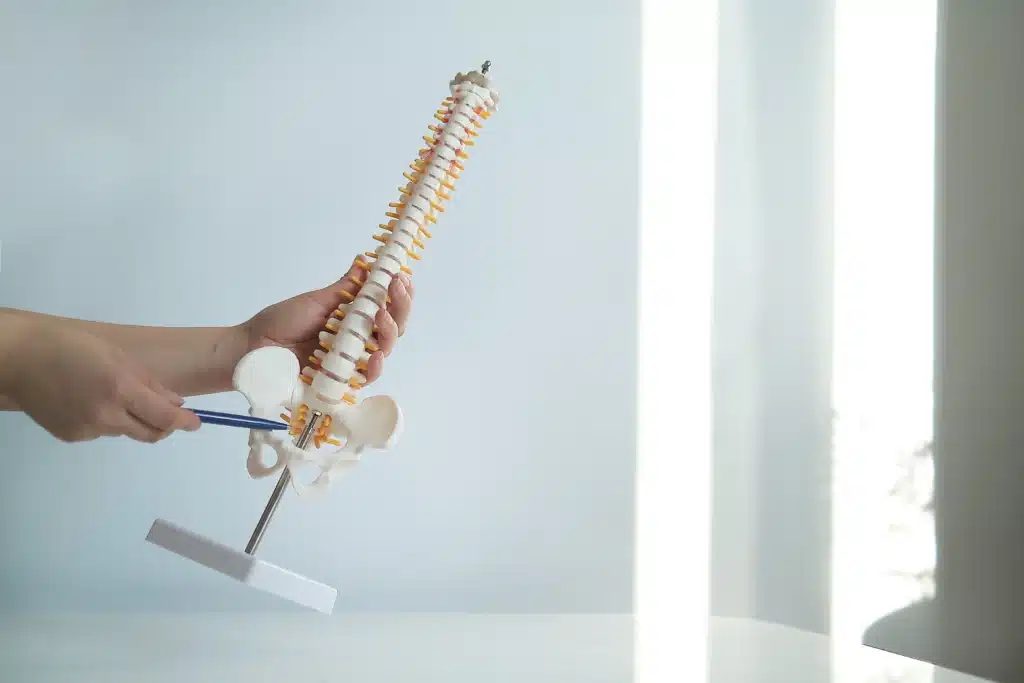
Table of Contents
ToggleWhen we talk about spinal fusion hardware types, we’re referring to the various tools and implants used during surgery to stabilize and support your spine. As a spine surgeon with over 25 years of experience, I’ve seen firsthand how the right hardware can make a significant difference in a patient’s recovery and overall outcome.
In spinal fusion surgery, the goal is to permanently connect two or more vertebrae in your spine, and the hardware plays a crucial role in achieving this. Click Here to know more on Spinal Fusion Surgery

In spinal fusion surgery, we use several types of hardware, each serving a specific function.
Each of these hardware types is chosen based on the specific needs of the surgery and the patient’s condition.
The decision on which spinal fusion hardware types to use depends on several factors. First, the location of the spine being treated is crucial. For example, the hardware used in the cervical spine (neck) differs from that used in the lumbar spine (lower back) because of the different stresses and motions involved.
The severity of the condition also plays a significant role; more severe cases may require more robust hardware to ensure stability. Patient-specific factors, such as age, bone density, and overall health, also influence hardware choice.
For instance, in older patients with osteoporosis, we may opt for larger screws or additional supports to ensure the hardware remains securely in place. These decisions are made with the goal of providing the best possible outcome for each patient.
Using spinal fusion hardware types offers several benefits, the most important being stability. The hardware helps to hold the spine in place as the bones fuse, reducing movement that could disrupt the healing process.
This stability is crucial for a successful fusion, particularly in areas of the spine that are prone to movement. However, like any surgical intervention, there are risks involved. Hardware failure is a potential complication, though it’s relatively rare with modern materials.
Sometimes, the hardware can irritate nearby nerves, or adjacent segments of the spine may degenerate faster because of the altered biomechanics after surgery. It’s important to discuss these risks with your surgeon, so you fully understand the potential outcomes and how they might affect your recovery.

The choice of spinal fusion hardware types can significantly impact your recovery process. For instance, minimally invasive hardware options, which involve smaller incisions and less muscle disruption, often lead to quicker recovery times.
Patients with these types of hardware may find themselves back on their feet sooner compared to those who have undergone more traditional, open surgeries with larger implants. Postoperative care and physical rehabilitation also play a critical role in how well you recover.
The type of hardware used will determine the specifics of your rehabilitation program, including exercises designed to strengthen the muscles around the fusion site and improve overall spine health.
In the last few years, we’ve seen exciting advancements in spinal fusion hardware types. For example, new materials like bioactive and carbon fiber composites have been developed, which are not only stronger but also promote better bone fusion.
These innovations reduce the likelihood of complications and improve long-term outcomes for patients.
Moreover, the rise of minimally invasive techniques has allowed for smaller, more precisely placed hardware, which means less damage to surrounding tissues and faster recovery times.
Patients today have more options than ever before, and these advancements are helping to make spinal fusion surgery more effective and less disruptive to their lives. Want to know more about Advancements in spinal fusion surgery. Click Here
One of the common questions I hear from patients is about the long-term durability of their spinal fusion hardware. Spinal fusion hardware types used today are designed to last a lifetime. Most hardware, such as titanium screws and rods, is incredibly durable and rarely needs to be removed.
However, in some cases, revision surgery might be necessary if the hardware causes discomfort or if there’s an issue with the fusion itself. It’s essential to have regular follow-ups with your spine surgeon to monitor the hardware’s condition.
While most patients won’t ever have to worry about their hardware once it’s in place, staying proactive about your spinal health can help catch any potential issues early on.
GET IN TOUCH +
285 Sills Road
Building 5-6, Suite E
East Patchogue, NY 11772
(631) 475-5511
184 N. Belle Mead Road
East Setauket, NY 11733
(631) 675-6226
GET IN TOUCH +
285 Sills Road
Building 5-6, Suite E
East Patchogue, NY 11772
(631) 475-5511
184 N. Belle Mead Road
East Setauket, NY 11733
(631) 675-6226
SUBSCRIBE TO OUR NEWSLETTER +
Send us a Google review. Click this link and let us know how we did!
Review us on Yelp too.